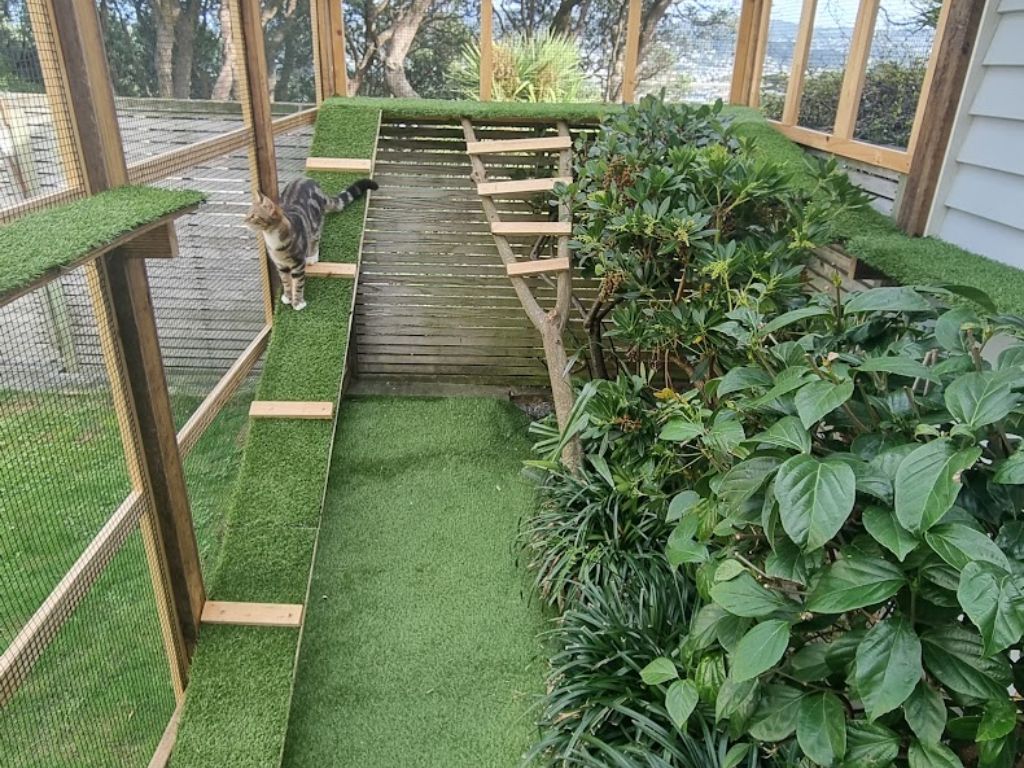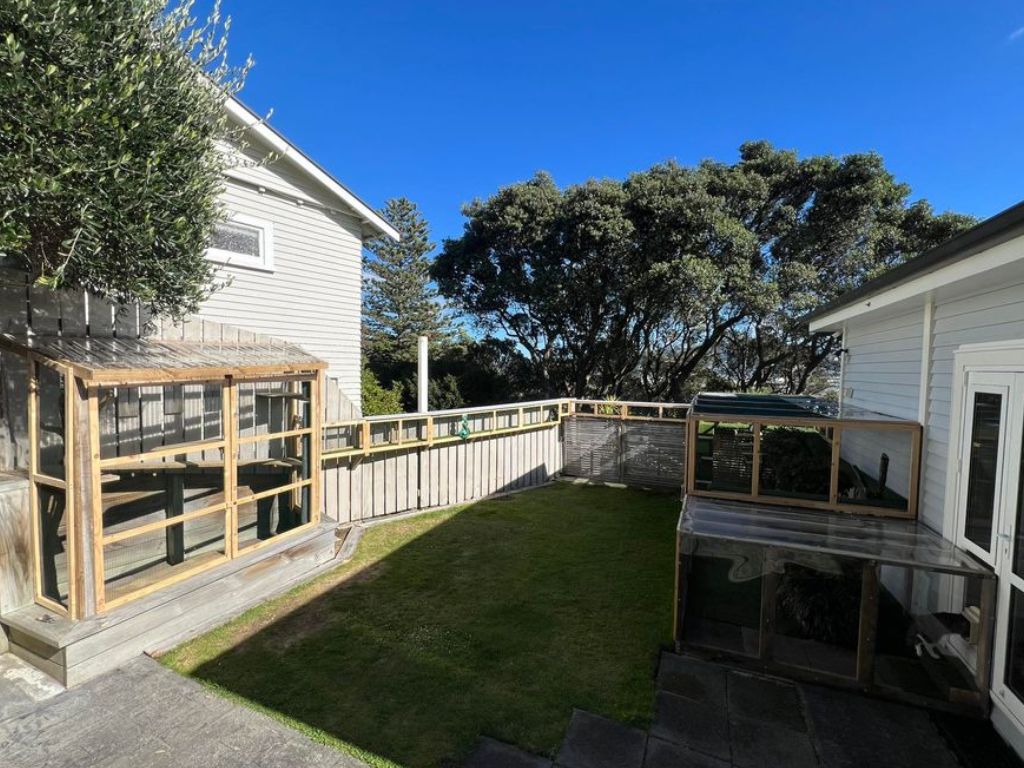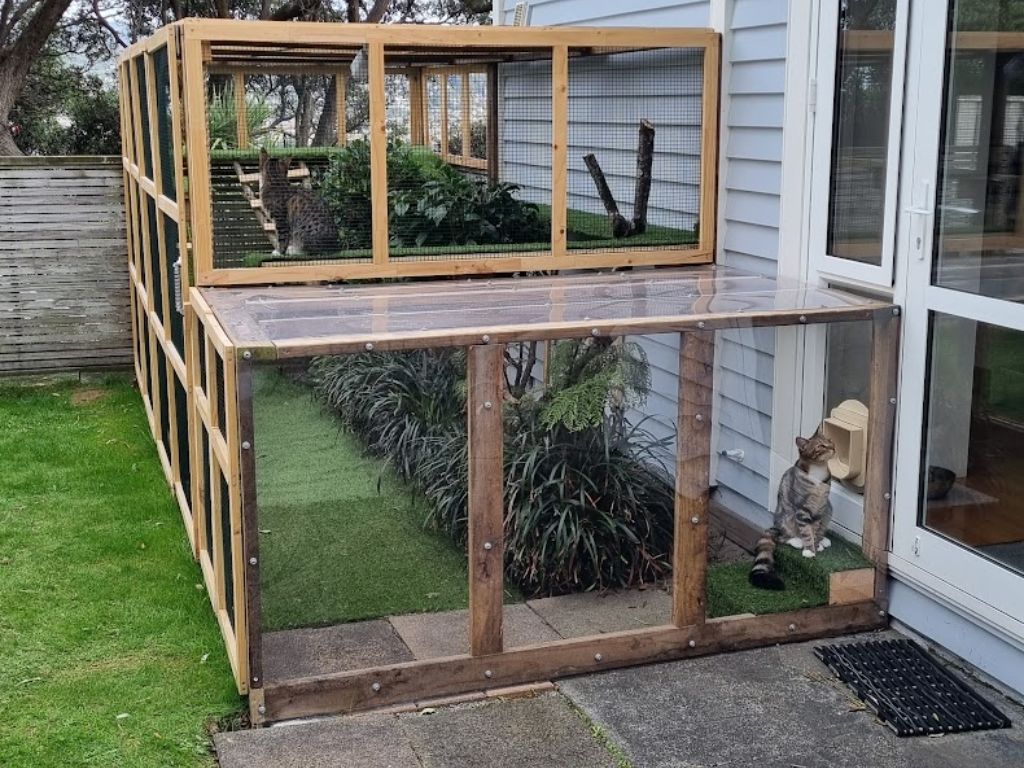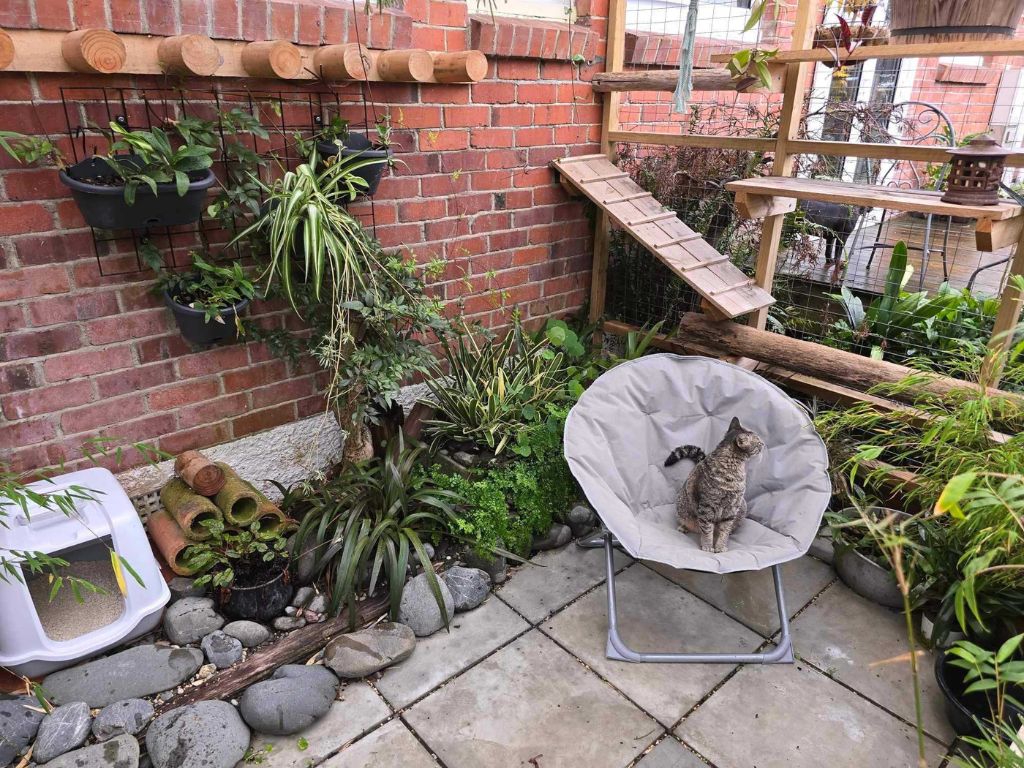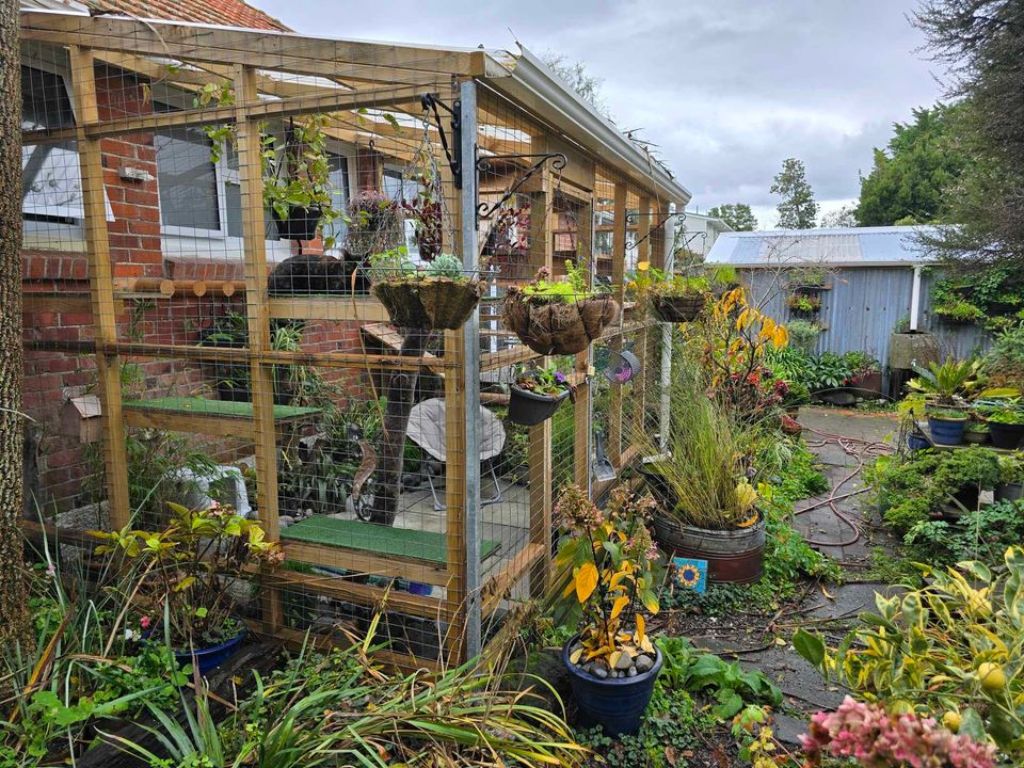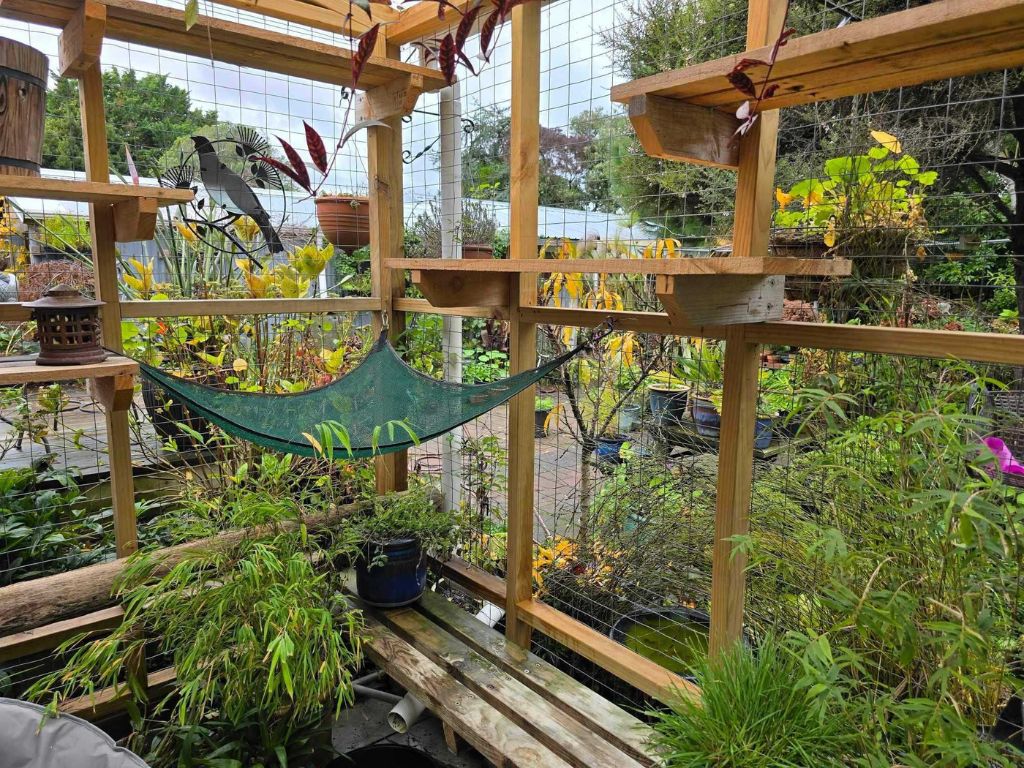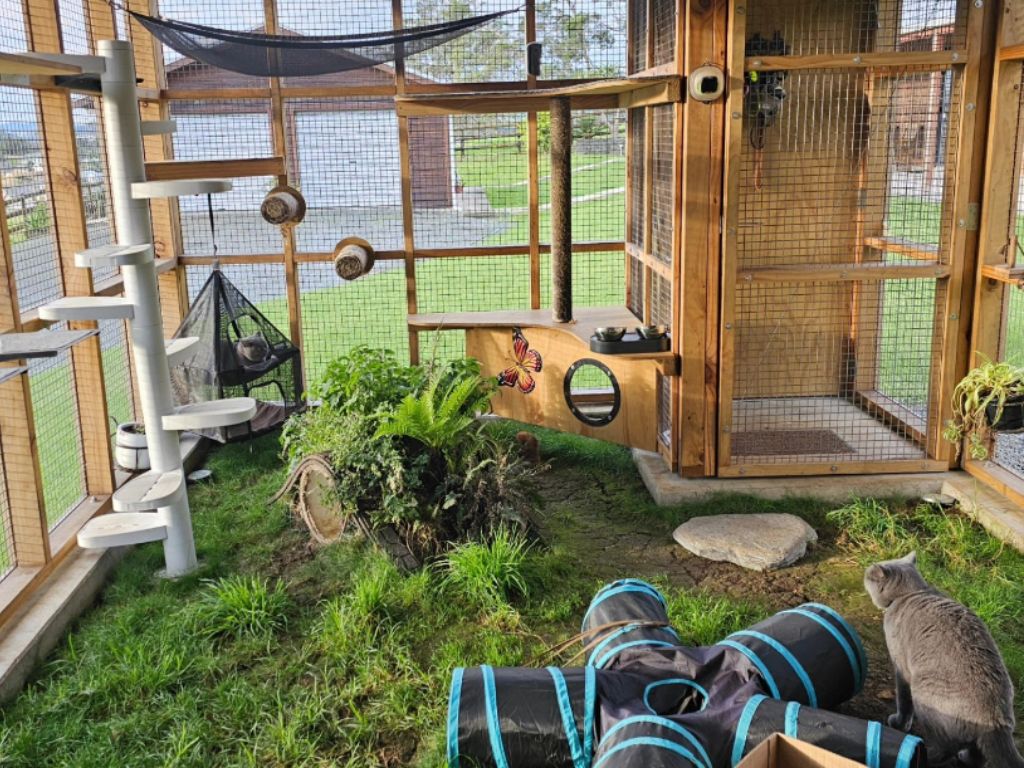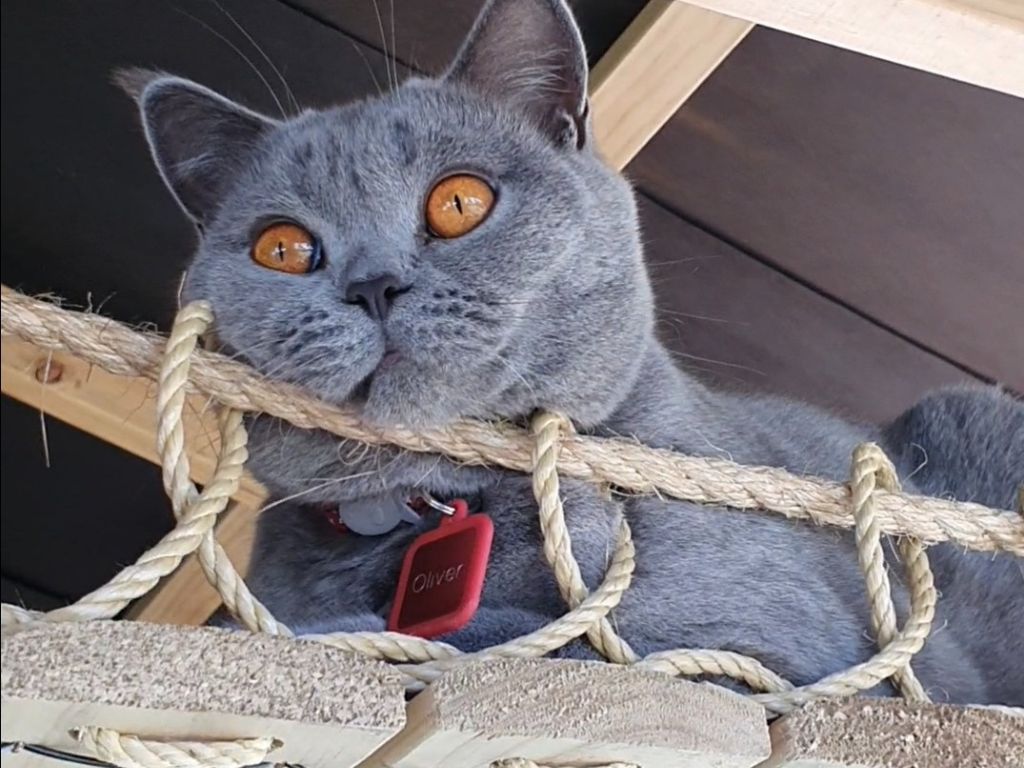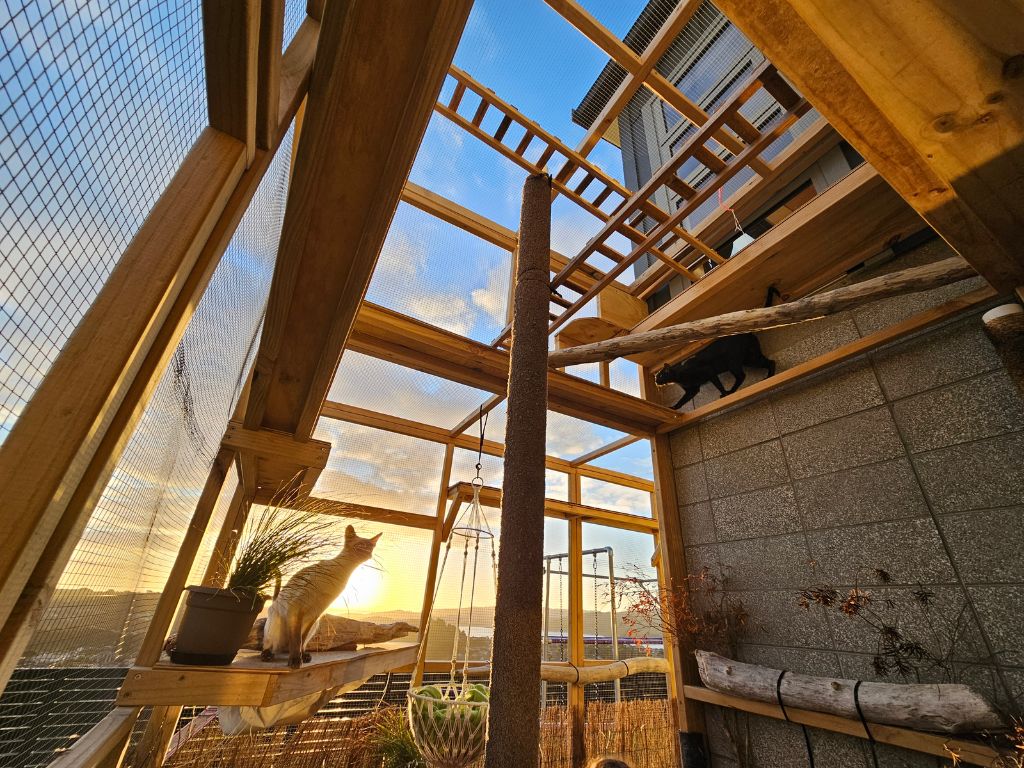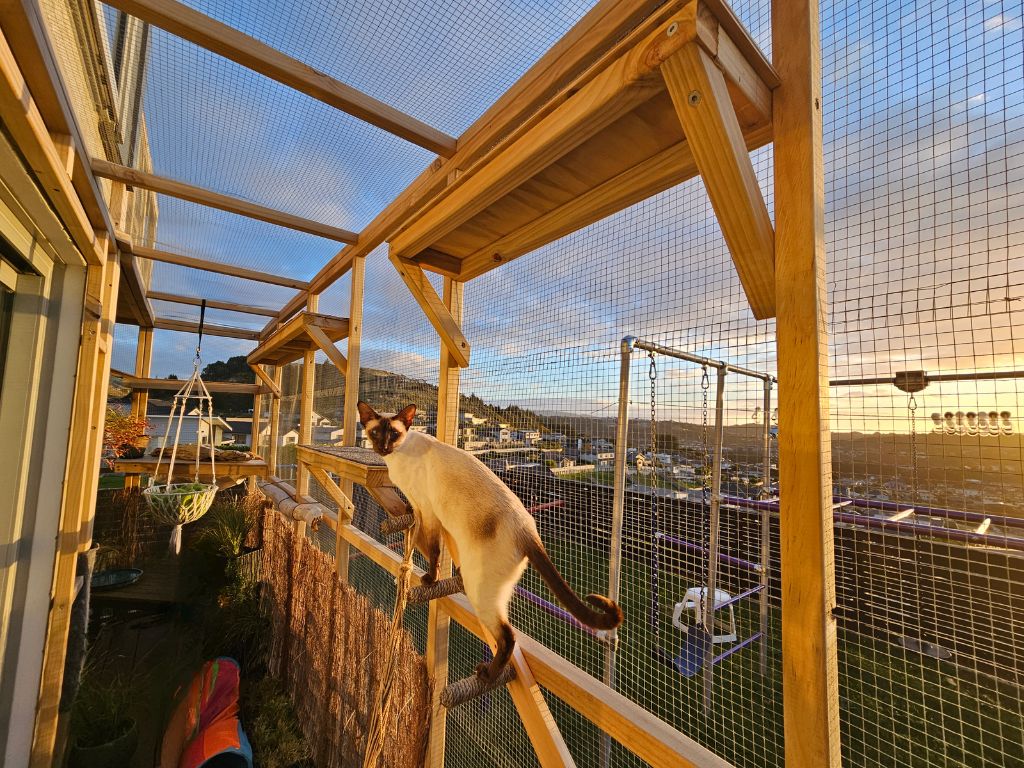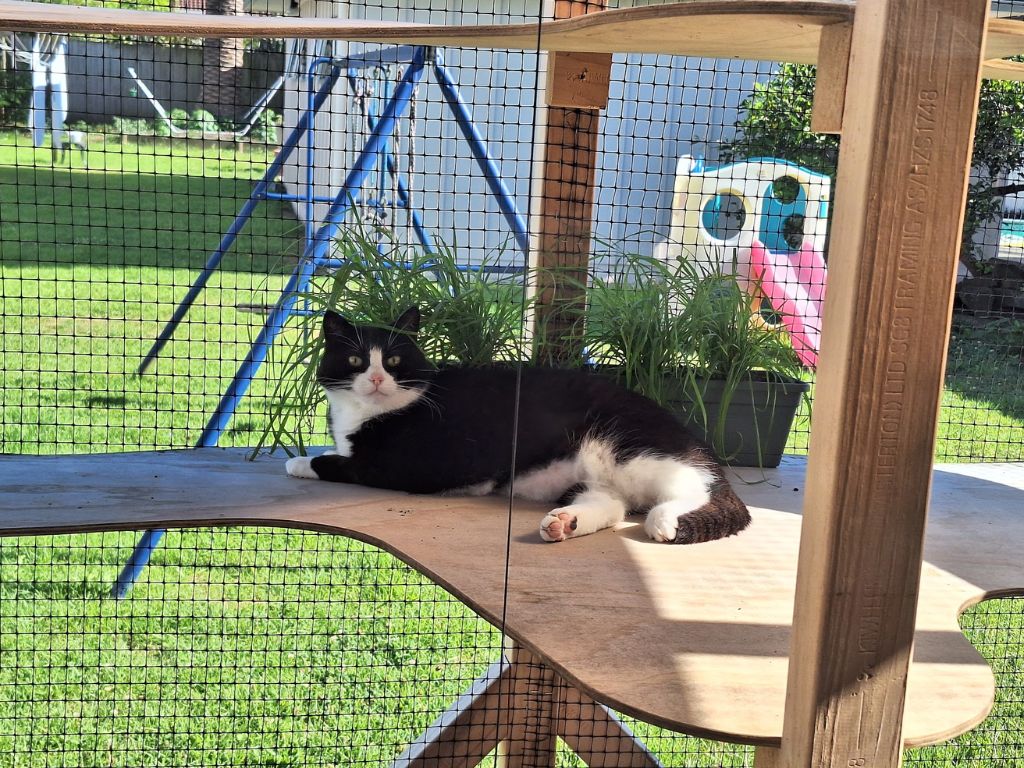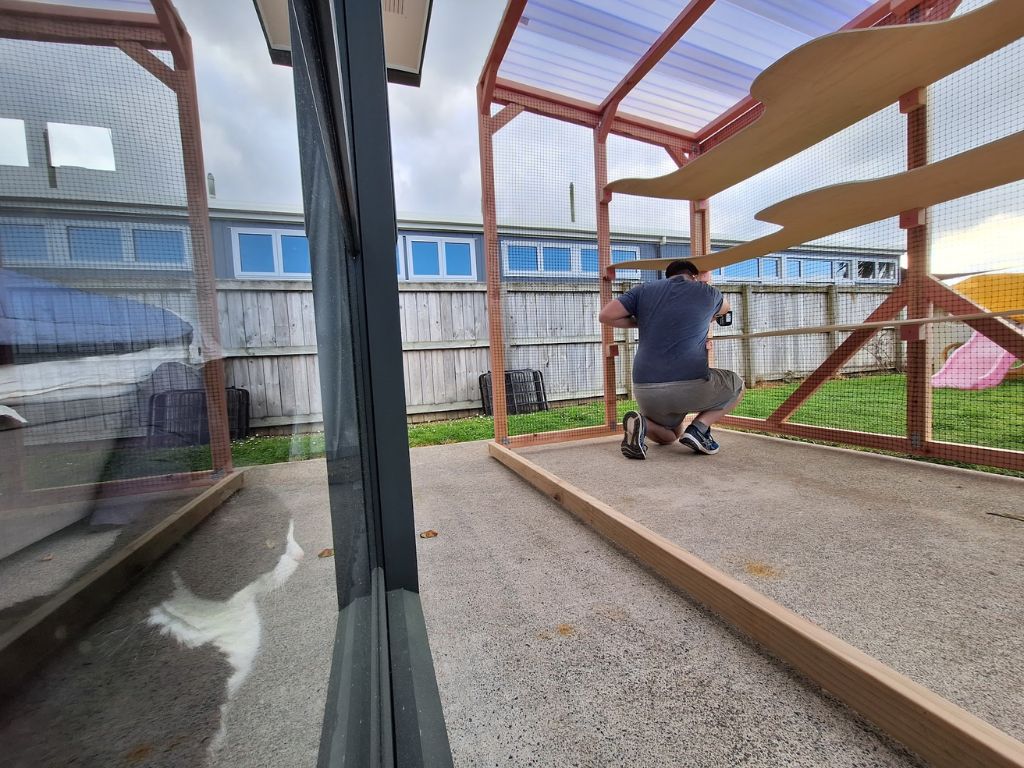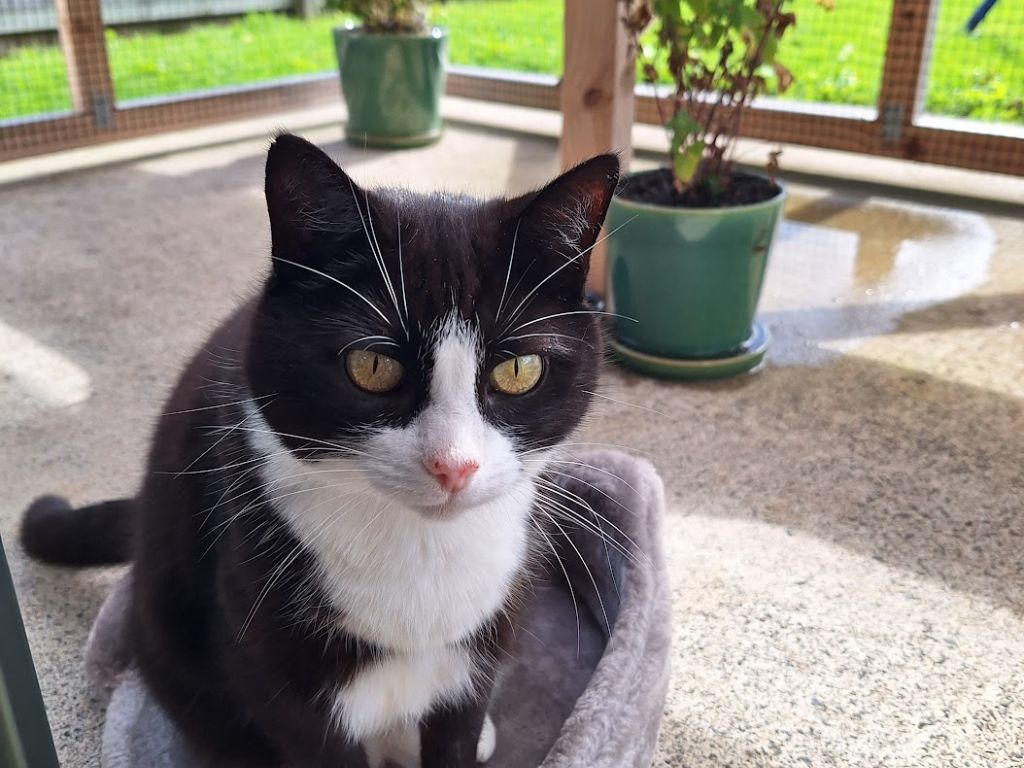Catio (noun): combining cat and patio, an enclosed outdoor area for a cat. While the featured catios are impressive, there are numerous ways to create a safe outdoor space for your feline friend, from affordable DIY projects to pre-made kits to custom professionally built options. We can give cats the best life and protect native wildlife—it’s not an either-or.
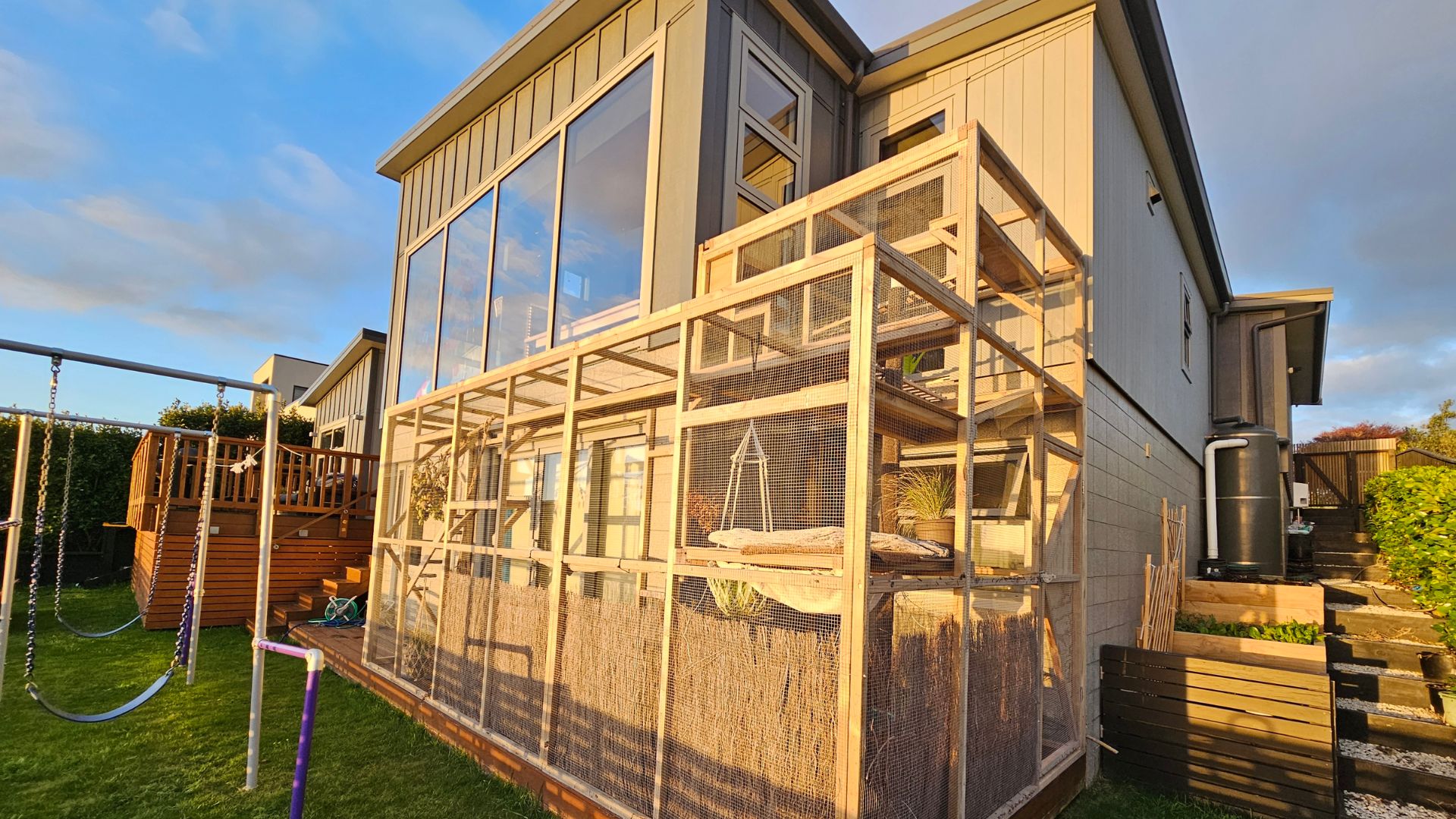
Kitty castle in a predator free zone, Te Whanganui a Tara (Wellington)
On any given afternoon, you can find Zinky and Xenon living large in their catio kingdom in Wellington’s predator free suburb of Miramar. Their owners, Ross and his son, Max, came up with the idea of building this kitty castle while waiting for their new cats’ vaccinations and desexing.
Using old decking timber, mesh, wooden batons, a power drill, screws and a staple gun, they spent a weekend putting it together.
They incorporated a garden bed for toileting and added bushes for greenery, covering the ground with leftover artificial grass for aesthetics and grip. They installed climbing ramps, platforms, a rope bridge, and discarded tree branches for extra climbing fun.
Ross reports they scavenged basically all materials, just buying timber batons and rolls of dark, plastic-covered mesh available at most DIY shops. They expanded their creation by adding a tunnel across the back fence to a sunnier, unused garden area, providing even more space for Zinky and Xenon to lounge and play.
Ross’s advice: “If you are going to build one yourself (and I would highly recommend doing so as it’s great fun), don’t think you have to plan it out in detail before you start building something. We started with a very vague sketch and then just made the details up as we went along. The challenges it presented and overcoming these made the result even more rewarding. We also did the build in stages and learned along the way what worked and what didn’t.”
Garden wonderland for two, Whanganui
Living on a busy main road with a blooming garden that attracts native birds was a recipe for disaster for Bonnie and her family, who have two cherished and energetic kittens. To keep Biddy and Luna safe and entertained, Bonnie’s handy husband built a roofed catio.
The catio features ramps and shelves made from free pallet wood. Driftwood makes for climbing and scratching poles. Bonnie included a hammock and a camping moon chair for sunny sleeping spots. Potted plants add greenery and hiding spots, and cat grass makes for tasty nibble options. The catio is perfect for zoomies, and they parkour around the shelves and ramps and wrestle on the floor. They also enjoy sitting and watching birds or Bonnie gardening – plus, it’s a safe retreat from the family’s keen puppy.
Bonnie’s advice: “Initially, exposed dirt and gravel tempted the cats away from the litter tray, so we covered the dirt with rocks and replaced the stone floor with pavers. To prevent escapes, we ran netting into the ground and placed large stones around the edge inside and out.”
Purrfect playground on a lifestyle block, Whangarei
Determined to keep her cats, native birdlife and furniture safe, Leeann and her husband created a feline utopia on their lifestyle block in Northland.
Blue British shorthairs Titan and Oliver enjoy the perks of the outdoors but none of the pitfalls. They don’t roam on Leeann and Andy’s 5-acre lifestyle block, but their spacious standalone enclosure (21 square metres) keeps them entertained and active. Leeann admits it’s extravagant, and she’s lucky to have a handy partner to do the building work, but it has provided a great life for her pets.
The timber-framed structure, elevated 10mm above a concrete foundation for airflow and durability, boasts a double-door entry system to prevent escapes. The boys get fitted into harnesses and led to their enclosure.
Inside, it’s a cat’s playground: DIY poles, ramps, a tunnel, a swing bridge, hammocks and snuggle spots ensure plenty of variety for the British shorthairs. Leeann crafted climbing poles out of PVC pipe and rope, and a swing bridge fashioned out of rope and garden edging. To top it all off, an automatic sifting kitty litter box keeps the enclosure clean and fresh.
Leeann’s advice: “I’ve planted a garden that cats enjoy, including catnip, cat grass, and ferns (all non-toxic to cats). I’ve placed solar-powered lights throughout, so it’s easy to light the enclosure up.”
You can follow Titan and Oliver on Instagram at @british_blue_boyz to see their adventures and get inspired for your catio.
Two-story Siamese sanctuary, Porirua
When Merete and her partner welcomed their two Siamese cats home to Whitby, they were determined to avoid hefty vet bills, the heartache of missing pets and the painful memory of a pīwakawaka family wiped out by a previous cat. They wanted quality time with Luca and Bissy rather than having them slinking off day and night.
They figured upfront costs would be a wise investment, with reduced vet bills and the mental cost of keeping track of the cats.
They enlisted the help of a local building company, Niche Building, to transform an underutilised section of their deck into a two-story feline fortress.
Builder Adrian brought their dream catio to life with a robust timber and wire mesh structure with platforms and ramps. Merete has been adding playful touches ever since. The pièce de résistance is a 3-meter downpipe wrapped in carpet, creating a colossal scratching and climbing post. The cats have 24/7 access to the catio and can be contained in it when needed.
Merete’s advice: “NZ Safe Cats – Catios and Cat Fencing is a great Facebook group to join to get catio ideas. People also put out feelers for recommendations for builders to build them. It’s very useful if you’re looking for realistic New Zealand-based inspiration.”
A cozy haven for a scrappy cat, Tāmaki Makarau (Auckland)
After a year of country living, Buttons the tuxedo cat, transitioned to an indoor life when her owner, Abigail, learned about the impact of urban cats on native bird populations. Additionally, Buttons’ tendency to come home with bleeding battle wounds from cat fights, once nearly losing her ear, reinforced the decision to keep her indoors.
To help her transition to indoor life Abigail and her partner constructed a custom DIY catio. Accessible through a ranch door leading onto a concrete patch, the catio is made of sturdy wood, secure mesh, reliable plywood and weather-resistant roofing materials. It’s spacious enough for humans to walk into. It has plenty of potted plants, soft cushions, and stable platforms for Buttons to sunbathe, birdwatch and climb, ensuring her safety and comfort.
Abigail’s advice: “Think like a zookeeper. Create spaces around your house and in the catio that encourage your cat to embrace their natural behaviours. Observe how your cat interacts with these spaces—how they use them, try to use them, or why they might avoid them. Adjust accordingly to ensure your cat is fully engaged and happy.”

